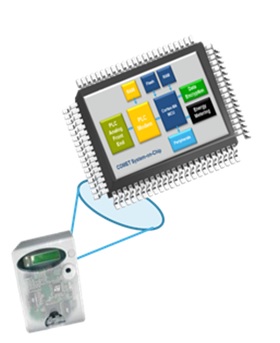Smart Metering - Making way to A Smart City
The India Power Sector is challenged by power loss during transmission and distribution. The Indian Electricity market is facinga serious challenge in providing continuous power supply to consumers.
March 06, 2018. By Moulin

Smart Metering - Making way to A Smart City
By Ms. Sapna Mongia , Head -Smart Grids and Metering, South Asia, Power and Discretes, STMicroelectronics
By Mr. Alessandro Moscatelli, Marketing Manager in charge of Smart Grids, STMicroelectronics
Smart Meter- The Indian Scenario
The India Power Sector is challenged by power loss during transmission and distribution. The Indian Electricity market is facinga serious challenge in providing continuous power supply to consumers. By implementing prepaid smart meters in the Residential segment Utilities can benefit by collecting the cash before consumption. By using the feature of“Remote Disconnect” functionality, Utilities can remove a customer who has not paid the bills. Consumers are able to monitor their energy consumption patterns and also watch their usage costs on anin- home display unit and as a consequence they changetheir consumption patterns. Consumers also adapt to use energy when it is cheaper as per the different schemes offered by the utilities. Also the in-bulit Tamper controls features in smart meters facilitate the utility to power theft. The consumer’s energy usage patterns are analyzed to detect unexpected consumption patterns, and can indicate a potential theft.The smart meters specification includes 6LowPAN, IEEE802.15.4/15.4g protocols and DLMS on application layer for communication... With DLMS as a standard application protocol smart meters will incorporate any future communication technology module.Smart metering is the key focus from government and the state utilities are focusing on smart metering to improve grid infrastructure.
Smart grid in India
Smart Grid in India is becoming the key application in Indian power sector. Smart meters will help toovercome the challenges in the power sector as they will enable utilities to access energy consumption data from remote without manually reading the meter. It will help in managing the power supply distribution from remote and it will benefit the consumers tomonitor and reduce their power consumption remotely as it will provide real time accurate power consumption data. This data can be accessed frequently as required and also available in the consumer premises on In-Home display unit. So the communication feature of the smart meter provides the utility to manage power load andreduce losses. Depending on the load requirement and by constant monitoring of the load of a particular area, the utilities can implement the different tariff plan for that area to manage peak hour’s demands. Also Smart meters will help to check the theft, power pilferage and monitor the quality of power supplied to the consumers
Communication Standards in Smart Metering
PLC is by far the most commonly adopted communication technology for smart metering, with more than 50 million installed points just in Europe, thanks to communication proven reliability and lower CAPEX and OPEX figures compared to other technologies. Among multiple available PLC technologies, European Commission has selected “Meters and More”, “PRIME” and “PLC-G3” as the most suitable standards for Smart metering roll-outs. Europe is one of the countries with the largest Power Line Communication based smart metering programs running on field and one of the most advanced in terms of regulations and standards framework guidelines. This experience is a valuable asset for all countries outside Europe who are approaching smart metering implementations and are looking for a cost-effective, reliable, interoperable and future-proof massive deployment. For smart meter to data concentration “last mile“ connectivity, “OPEN meter” project selected Power Line Communication (PLC) as the most suitable technology. Among several PLC technologies and specifications analyzed, including both narrow-band and broad-band technologies, only three open communication specifications have been selected as able to satisfy the AMI defined architecture and requirements: “Meters and More” (then published as CENELEC CLC pr TS 50568-4 standard), “PRIME” (then published as CENELEC CLC pr TS 50567-1 standard and ITU-T G.9904) and “G3-PLC” protocols (then published as CENELEC CLC pr TS 50567-2 standard and ITU-T G.9903).
Our new platform STComet that is complete meter system on chip. STCOMET is a device that integrates a power line communication (PLC) modem, a high-performance application core and metrology functions. STCOMET SoC has become one of the first two ICs to complete the new G3-PLC™ certification program announced by the G3-PLC Alliance in September 2014.



please contact: contact@energetica-india.net.

















